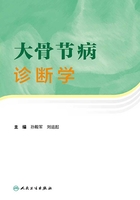
第二章 大骨节病临床诊断 Chapter 2 Clinical diagnosis of Kashin-Beck disease
【本章摘要】 大骨节病是典型的地方病,病区接触史是严格的必要条件。大骨节病临床严重程度分为Ⅰ度、Ⅱ度、Ⅲ度,Ⅰ度为手指关节增粗; Ⅱ度为短指(趾)畸形; Ⅲ度为在Ⅱ度的基础上加身材矮小畸形。大骨节病的发生发展相对缓慢,多数病人发病初期无明显症状,部分病人在发病初期感到虚弱,容易疲乏、无力,肌肉酸痛、发紧,四肢有蚁走感、麻木感等。典型病人四肢关节发紧,运动不灵活,轻微活动后可有所缓解;关节疼痛,尤其四肢关节疼痛是多数病人的主要症状。早期病人手指向掌侧轻度弯曲,指末节呈鹅头状下垂;关节增粗始见于手指和足趾关节,逐渐发展到腕、肘、膝和踝关节;晚期重症病人肩和髋关节均可受累。指间关节增粗状如算盘珠,手指末节背部可看到或触到一个横行的“脊” 称为赫伯登氏结节。重症病人可见短指、短肢畸形,手指、足趾、腕、肘、膝、踝关节可见脱位或半脱位,病人身高与年龄不相称,四肢与头和躯干相比表现为不匀称性短缩,上臂与前臂相比特别短。
【Abstract of this chapter】 Kashin-Beck disease is a typical endemic disease.Exposure history in the disease area is the strictly necessary condition.According to the clinical severity,KBD is divided into Degree Ⅰ, Ⅱ, Ⅲ.Degree I is the enlargement of finger joints, GradeⅡis brachydactylia and Degree Ⅲ is short limb deformity.The progression of KBD is relatively slow.Most patients have no obvious symptoms in the early stage of onset.Some of the patients feel weak in the early onset and become easy fatigue, muscle pain, formication of limbs,numbness, etc.The typical patient′s joints are tight and the joint movement is not flexible,but after slight movement the syndrome can be relieved.The joint pain, especially the joint pain of the four limbs, is the main symptom of most patients.In early stage of KBD, the fingers of patients bent slightly to the palm side with fingertip drooping like goose-head shape.Joint thickening occurs in finger and toe joint, and gradually develops to the wrist, elbow, knee and ankle joints.Shoulder and hip joints can be affected in the late stage of severe patients.Interphalangeal joints thicken like abacus beads, a transverse ridge called Herb′s tubercles can be seen or touched on the back of fingertips.Severe KBD patients may have short finger or short limb deformity.and dislocation or subluxatio can be seen in the fingers, toes,wrist, elbow, knee and ankle joints of the patients, their height and age are not commensurate, four limbs show unsymmetrical shortening compared with their heads and bodies, the upper arms are especially shorter than their forearms.
大骨节病属地方性畸形性骨关节病,绝大部分病例发生在儿童管状骨干骺闭合以前,原发病变是四肢骺软骨、骺板软骨和关节软骨的变性、坏死,广义上属于骨软骨病范围。伴随着原发病变的恶化、扩大,相继出现邻近部位骨组织的破坏、增生、改建、变形,直至构成典型的骨性关节炎。